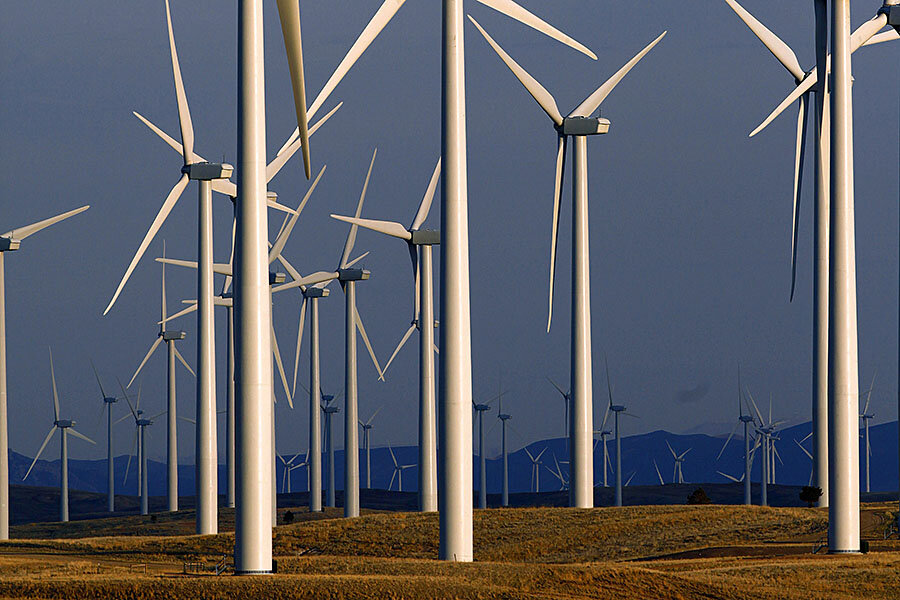US energy's big transformation [Recharge]
Loading...
Recharge is a weekly e-mail digest of energy news and analysis written by Monitor reporters David J. Unger and Jared Gilmour.
Transformation: Coal plants will shutter, natural gas will keep booming, and renewables will come online in record numbers. That’s the vision outlined in a new BNEF report that posits 2015 will be a “watershed year” for decarbonizing US energy. Oil and coal remain overwhelmingly dominant in the mix, but the world's No. 2 emitter may very well be approaching a critical mass in a shift to lower-carbon fuels. The combination of record carbon-heavy retirements with record carbon-light installations could rapidly accelerate a transformation of US energy.
LNG: Shell’s $70 billion deal to acquire BG Group this week could be the first in a wave of mega-deals in the industry after months of low oil and gas prices. Perhaps more importantly is what it signals for the future of LNG. Shell’s tie-up with BG will bolster its potential to dominate LNG markets in Asia and beyond. As countries work toward a global agreement to slash emissions, Shell’s move toward the cleaner-burning gas is a bet that LNG will supplant coal as the driver of future global development.
Americas: US shale and cheap oil are shifting power in the Americas away from Venezuela and toward the US. Oil-rich Venezuela has exerted influence on Cuba and others, but when oil prices collapsed so did its influence. That created an opening for the US – whose tourist dollars could help Cuba – to normalize relations. In a Jamaica visit Thursday, Obama challenged Venezuelan influence, promising US energy assistance for the Caribbean. But progress with Cuba and the Caribbean could be overshadowed by souring US-Venezuela relations at the Summit of the Americas this weekend.
In the pipeline
- Monday, April 13: BRUSSELS – The Carnegie Endowment for International Peace releases its oil-climate index in Europe, hosting a conversation on the varying climate impacts of different kinds of oil.
- Tuesday, April 14: WASHINGTON – A House subcommittee focused on trade holds a hearing on whether the decades-old ban on US oil exports is “helpful or hurtful.” It’s part of broader movement on Capitol Hill to broach changing the policy. Lifting the ban is controversial because some in Congress worry that exporting US oil could raise – or could be perceived by voters to raise – the price motorists pay at the pump.
- Friday, April 17 to Sunday, April 19: WASHINGTON – The IMF holds its spring meeting, jointly held with the World Bank. Close to 20 percent of the World Bank Group’s lending is for climate finance, and the two groups are expected to discuss how to increase that number.
Drill deeper
In California and beyond, drilling for oil as water runs short
[The Christian Science Monitor]
Californians are being asked to cut water usage 25 percent amid the worst drought in state history. Should the state’s oil industry cut back, too? It's a question arising worldwide as energy consumption grows and water becomes scarce, particularly in states like Texas where oil wealth is coupled with serious water scarcity.
Imagining a Post-Coal Appalachia [The Atlantic]
“How do we move forward as a region? The way that we do that is from within the region,” says Ethan Hamblin, a 23-year-old staying in Appalachia as coal declines. “It’s not seeking outside funding, it’s getting the people on the ground working together across county lines, across state lines, and thinking about how we do that work together.”
Iranian oil could send an already-saturated market back into a price nosedive [Quartz]
If a deal limiting Iran’s nuclear program reaches the finish line – and that’s a big if – sanctions that kept Iran’s oil out of the market will ease. Iran would take time to ramp up production, but the country has 35 million barrels of surplus crude that could hit markets quickly – and that much oil, even sold over a period of time, could put prices in a tailspin.
Energy sources
- EIA: "The drought has limited the state's ability to generate electricity from its hydropower plants … 2013-14 precipitation in the Northern Sierra, where some of California's largest hydropower plants are located, was 37% below the historical average. Precipitation in 2015 continues to be exceptionally low."
- BNEF: "In 2015, the US will install more renewables than ever before, with 18 new gigawatts (GW) coming online. BNEF forecasts new solar installations to reach an all-time annual high of 9.1GW in 2015 … Wind build should total 8.9GW ... It will be a record year for coal retirements in the US with 23GW forecast to come offline. That represents no less than 7% of all current US coal capacity."
- President Obama: "[O]ftentimes people of the Caribbean, despite having less resources, are paying significantly higher prices for energy. And if we can lower those costs through the development of clean energy and increased energy efficiency, we could unleash, I think, a whole host of additional investment and growth. And I think there are going to be a whole host of areas where the United States can be helpful."
Unplug
By 2030, roughly 9.6 million residential electricity customers in the Northeast US could shift to grid-connected solar-and-battery power systems, according to a new study by Rocky Mountain Institute. That represents half of the region's utility residential kilowatt-hour sales worth approximately $15 billion in revenue.
– "The Economics of Load Defection" by Rocky Mountain Institute
Recharge is a weekly e-mail digest of energy news and analysis written by Monitor reporters David J. Unger and Jared Gilmour.








